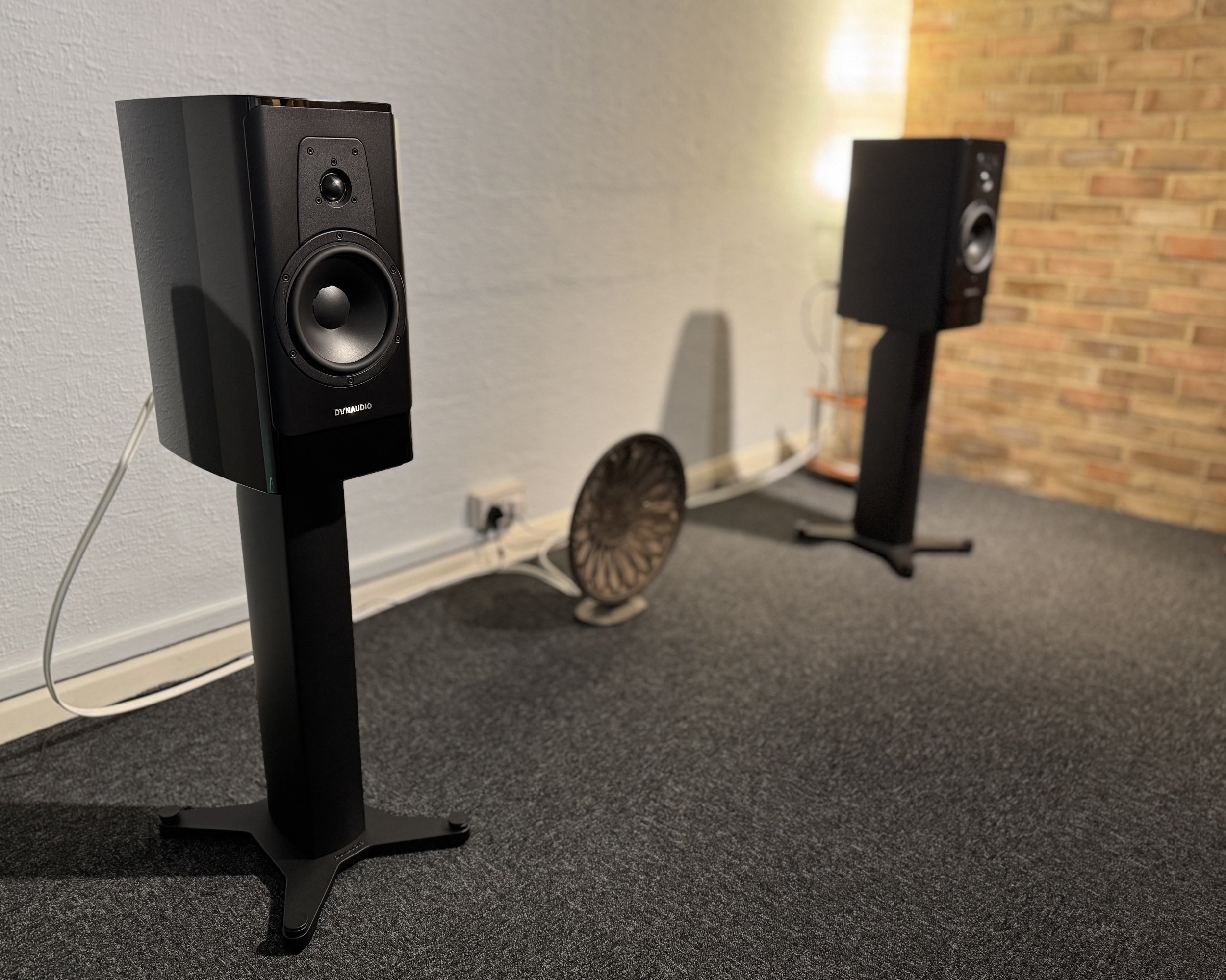Staff System Upgrade: The REL T/7x Sub-Bass System
/Working in the big-person toyshop as we do, it’s all too easy to have our heads turned by the latest shiny thing – and this big person frequently does. My second system (the one in my kitchen-diner) is the one that sees the most music played through it at home. My primary system is usually reserved for films, gritty crime series, and sport. No coincidence, then, that I’m always quietly on the lookout for a performance improvement for the kitchen setup.
TYPICALLY ARTY SHOT OF A rel t/7x, showing of how very shiny it is. YOU DIDN’Y REALLY EXPECT ANYTHING ELSE, DID YOU?
As space is at a premium, I’ve got a Bluesound Powernode amp/streamer tucked away on top of the fridge-freezer, and a pair of Bowers & Wilkins 707 compact loudspeakers perched on top of the kitchen cupboards, isolated with IsoAcoustic Orea Bronze isolation pucks.
The source components of my system. Bluesound powernode and the rel arrow signal sender unit
This setup was perfectly enjoyable, but I felt it sounded somewhat anaemic and lacking in scale, so I added a REL T/7i subwoofer to support the lower octaves. The result was a very worthwhile improvement, but I could hear the T/7i struggling to load the room effectively—what with the double French windows and the single Welsh (?) window eating most of the available bass.
BOWERS AND WILKINS 707 S3’S ON THEIR DEDICATED STANDS. COULDN’T GET A GOOD PHOTO OF THEM IN-SITU SO HAD TO REVERT TO STOCK. THEY ARE VERY LOVELY.
I’ve always fancied running a second subwoofer in my home cinema system (typically, we use the second REL to support the centre speaker, having set the centre channel to full-range in the AV processor), ever since I heard one in a demo at REL’s HQ in sunny Bridgend, South Wales. I’ve convinced many customers to do the same and have installed plenty of centre-channel-supporting REL’s in my career, but I’ve never quite managed to get round to installing one at home. The mechanic’s car and all that, I suppose. More on that in a later blog…
Favourable circumstances led me to acquire a shiny new REL T/7x. The latest REL T-Series are now much more like a miniaturised S Series, rather than simply a beefed-up T/5–7–9i, and they’re rather more premium than before. The T/7x features a front-firing 250mm long-throw active driver, powered by a 200W Class AB amplifier. The familiar Neutrik speaker-level connector remains alongside the regular line-level inputs and the clever wireless “Arrow” system input. A downward-firing passive radiator (in this case, a 200mm long-throw unit) is installed in its base. T/x Series cabinets are no longer equal-sided cubes; they’ve been given a more discreet look, helped by those radiused corners that seem to appear on just about everything these days. It isn’t just decorative—we’re reliably informed that the cabinets are now stiffer, and although they look smaller, internal volumes have been slightly enlarged compared to previous models.
AN EVEN ARTSIER IMAGE OF A REL T7X WITH the rel ARROW SIGNAL RECEIVER PEEKING OVER ITS BACK.
The new three-strong Serie T/x range represents a fresh starting point for subwoofer experts REL, and the Serie T/7x (sitting between the T/9x and T/5x) hits something of a sweet spot: a good balance between price and performance that made it the right choice for me. Mine nestles out of sight, between the shoe cupboard and the cat’s basket. Don’t fret—she never uses it when I’m playing music, curiously enough.
THAT REL ARROW V3 WIRELESS KIT IN ALL ITS GLORY. AN ABSOLUTE DODDLE TO SET UP AND USE, even with multiple units. one of my customers has three wireless rels running in his astonishing home theatre..
A subwoofer in an audio setting has to balance bass depth, speed, and integration with the rest of the loudspeaker sound. This differs from the requirements of a traditional home cinema setup, where the subwoofer is considered a channel in its own right, rather than a reinforcement of a pair of speakers. REL subwoofers are designed to do both. Typically, a REL unit will deliver the LFE channel while also providing bass support for the front left and right speakers—freeing the processor from the task of apportioning bass away from those speakers and to the sub. The result? More bass detail and a sensation of “freeing up” the soundstage. It’s one more veil removed from between the audience and the original soundtrack.
Set-up remains the same as with the T/7i. You can either use the Speakon cable and high-level input—wiring the cables to the left and right positive terminals and a single negative terminal on your amplifier—or, as in my case, use REL’s proprietary Arrow wireless system. It connects to the amplifier in the same way as the Speakon 3-cable method, but uses a very short cable that attaches to a sender unit. This unit pairs with its receiving mate, which is bolted to the subwoofer via a 9-pin plug. I’m happy to report the pairing process is a doddle. Play a simple vocal recording with the T/7x’s gain and crossover controls initially set too high, then dial them down until the sub is just past the point of audibility. Confirm everything’s working with a track featuring a good bass player—‘We Supply’ by Stanley Clarke, perhaps?
THE CLASSIC REL SPEAKON CONNECTION, AMPLIFIER END. NOTE THE TWO POSITIVE SIGNALS WITH ONLY ONE RETURN (NEGATIVE) REQUIRED. THE FULL-BANDWIDTH SIGNAL OUTPUT FROM THE AMPLIFIER IS SAMPLED AND SUMMED INTO A MONO SIGNAL THAT THE SUBWOOFER CAN REPRODUCE.
Get it right in audio, and it’s like you’ve given the main speakers the freedom to be themselves—opening out the soundstage, offering better midrange clarity, and focusing the sound more tightly and accurately. You’ll know, because your body will instinctively start shaking various parts of itself in time with the rhythm. Get it wrong, and you end up with a speaker that slows the music and booms along with the song, undermining everything that made your system sound good in the first place. Happily, REL has always batted well above average when it comes to making a subwoofer that integrates beautifully into a domestic audio system.
After setup, I played music as normal—although if I favoured a bit of Reggae Dancehall and M’darlinghoneybunny’s workout playlist while stir-frying our dinners, I’m sure you’ll forgive me. A week later, I put my technician’s head back on, turned the T/7x down a notch or two, and voilà! What the T/7x does is introduce a bit of extra speed and a lot of solidity to the bass—the sort of performance you’d normally expect from more upmarket models in the range. Weight is a tricky subject, because the Serie T/7x doesn’t make a small speaker seem simply ‘weightier’, but instead ‘bigger’—and, more importantly, ‘better’—across the midrange, and much, much more satisfying.
honestly, it’ll scare the living daylights out of you. heaven knows what she’s getting up to to this.
‘Hypermusic’ by Björk is appropriately room-filling, Yo-Yo Ma’s Soul of the Tango album is impossible to stay still to, and ‘Gunfinger’ by IRAH feat. Chase & Status (courtesy of the aforementioned workout playlist) is absolutely terrifying.
Compared to my previous REL T/7i, the new T/7x offers both more substance and form, with less intrusion into the sound of the speakers. The speed of the Serie T/7x is its standout feature. Few subwoofers deliver both bass depth and bass speed like this one does—especially at anything close to this price—and for that alone, it deserves very high praise. It means the T/7x can keep up with fast musical transients played through equally fast and reactive loudspeakers, like my 707s. Add in the kind of depth that can fill out floorstanders in this category, and it becomes an exciting addition to our audio armoury.
Thanks, Rob! (You know who you are.)
Thanks for reading.
Words by Adrian, images by Nic, tea by Andy at Audio T Swansea
If you have any questions about any of the equipment featured in this article, or any other Hi-Fi or home cinema enquiries, be sure to Contact Us
If you’ve enjoyed this, why not go ahead and read some more of our other blogs and be sure to follow us on our social media channels below…
REL can be found at the following Audio T stores:



































